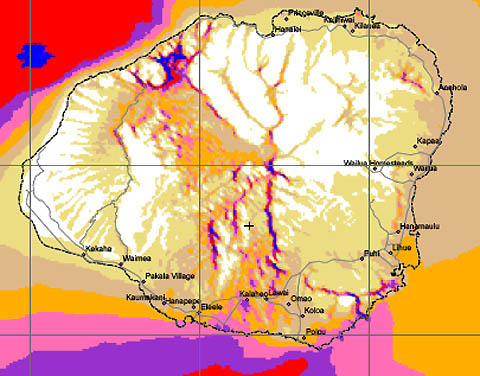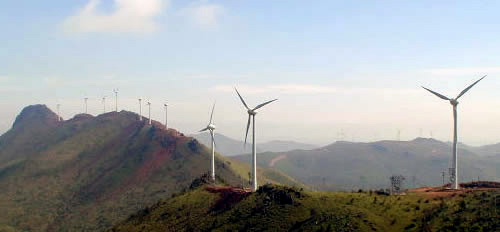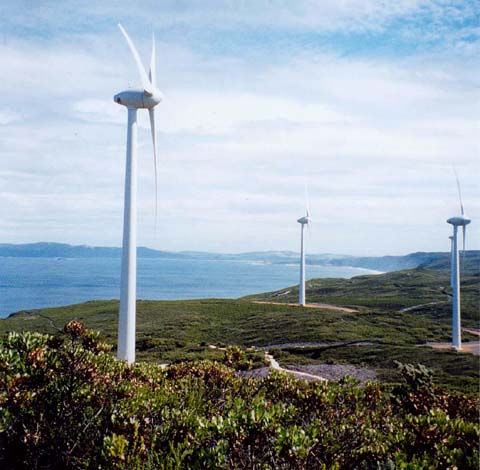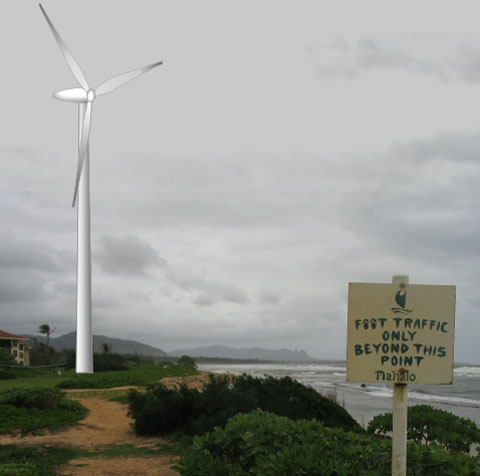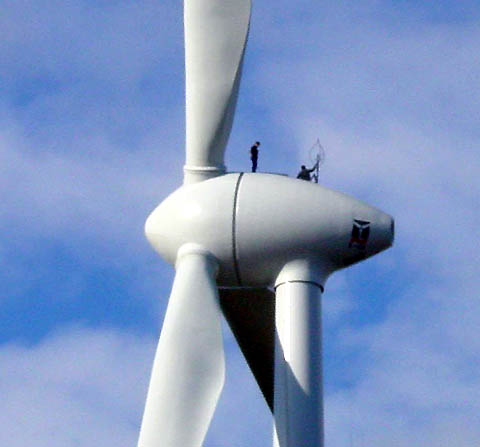SOURCE: DIANA LABEDZ DianaLaBedz@aol.com
POSTED: 5 JUNE 2006 - 6:00pm HST
Wind Power in Limbo
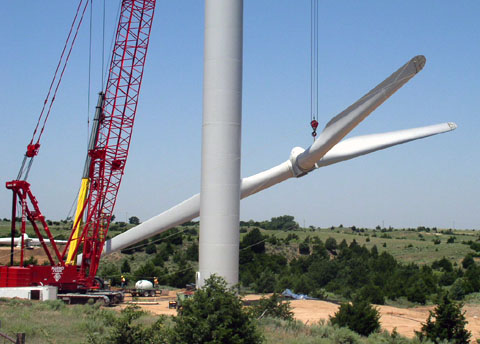
Blade lift at the Oklahoma Wind Energy Center in Woodward County in 2003. Click on image for more.
| Study
to examine windpower effect on military by Andrea Frampton & Erinn Deshinsky 2 June 2006 in Peoria Journal Star A study prompted by national security concerns involving radar will affect wind-power development in Illinois and around the country, an official for a wind energy company said Thursday. "It's stopping the progress of literally millions of dollars of projects," said Tim Polz, site manager for Chicago-based Midwest Wind Energy. The company has two projects slated for construction in 2007 in the Bureau County region. The study, prompted by a clause in the 2006 Defense Authorization Act, calls for an assessment of the effects of windmill farms on military operations. The Department of Defense and the Department of Homeland Security asked the Federal Aviation Administration to monitor possible wind farm problem sites, according to FAA spokeswomen Elizabeth Isham Cory. The FAA began issuing notices of "presumed hazard" to wind project contractors in January for sites within 60 nautical miles of long-range radar installations, she said. The study's main purpose, Defense Department spokeswoman Eileen Lainez said, is to determine the effect wind farms have on radar systems' ability to defend the nation's borders. "We just want to stop new construction (to find out if) it is affecting our nation's security," Lainez said. "We're not talking about the specifics of the study until it's submitted to Congress." In McLean County, construction of the $600 million Twin Groves wind farm in Saybrook is behind schedule, but not because of federal intervention, according to a developer with Horizon Wind Energy. Work has been delayed to finalize agreements with landowners, said Michael Skelly, chief developer with Texas-based Horizon Wind Energy. He said construction should begin the end of this month. With 240 turbines, each 260 feet tall, planned to generate 400 megawatts, the Twin Groves wind farm will be one of the nation's largest and is estimated to provide enough power to light up 120,000 homes. "The FAA order has affected a lot of wind projects around the country, but we got our wind permit two days ago," Skelly said Thursday. "They looked at it more closely, and (a solution) was found because we did get a permit." The study on wind farms and radar should have been completed no later than 120 days after the Defense Authorization Act took effect in January. Defense Department spokeswoman Lainez said she does not know when the study will be completed. Polz said he hopes the study will be concluded soon, because without a resolution, his company cannot begin building the farms, which include a second phase of the Crescent Ridge wind farm near Tiskilwa and a new 200- to 250-megawatt Big Sky wind farm near Ohio. Polz said his company is moving forward with both projects, but added that it's possible - if the study shows the turbines do cause interference - the FAA could shut projects down. Other planned projects in the area include the 64-megawatt Eurus Crescent Ridge II wind farm near Tiskilwa, and an 84-megawatt GSG LLC wind farm in LaSalle and Lee counties near Mendota owned by Bruce and Joyce Papeich. Michael Vickerman with Renew Wisconsin, a not-for-profit wind farm advocacy group, said four large-scale wind farm projects in Wisconsin are delayed because they are near airports. He said instances have been documented in which test planes lost radar for "a handful of seconds" while flying over a wind farm. But technology is now available to eliminate interference caused by objects such as cell towers and wind turbines, Vickerman said. "It's absurd," Vickerman said. "There are wind farms operating near Air Force bases." Vickerman said contractors will have to delay buying turbines, and the high demand for turbines will increase prices by 20 percent next year. "The economic damage is widespread from this policy. Just about everyone suffers," Vickerman said. Polz added there are already wind farms within the area of facilities using military radars. "So they should already know the effects," Polz said. "We would hope, along with everyone else in this industry, what they come out with is reasonable," he said. Rory Cox:
Pacific Environment - California Program Director |
SOURCE:
STEVE MILEWSKI smilewsk@earthlink.net
Reaction to windmills from Maui
28 May
2006 - 1:00pm
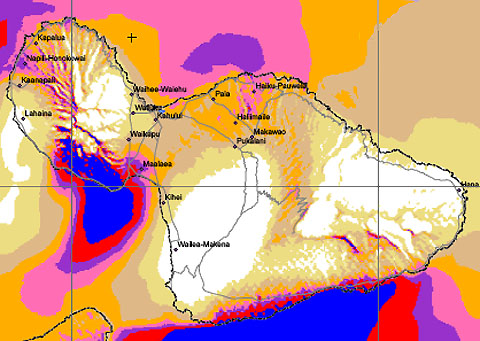
map of Maui windpower at 50 meters above ground.
Note intensity in West Maui below Lahaina.
Like a stitched wound catching the morning sun I saw the
article below about the wind generated power and what the Kauai
mountain ridge might look like should the plan go ahead.
|
SOURCE:
JUAN WILSON juanwilson
@earthlink.net
The look of wind power
13 May 2006 - 12:00pm
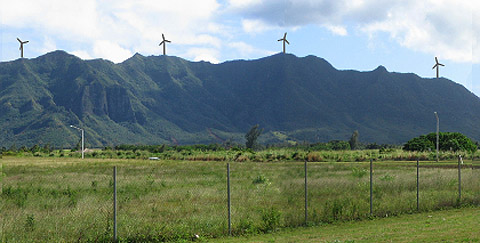
the view of Kipu mountains with several 1.6
megawatt windmills on ridge. Click on image for overview
by Juan WIlson & Jonathon Jay on 13 May 2006 In the simulated illustration above the Kipu Mountain range is shown with a line of Vestas NM82 windmills. The towers supporting the generators are 262 feet high. Each blade of the wind turbine is 135 feet making the total height of the windmill 397 feet; about the height of a forty story building. Hokulei Peek, in the middle of this image is 1666 feet above sea level. A closer view of this kind of ridge application might look something like the following. Mountain ridges are a practical location for windmills even though access may be difficult. Ridge are natural places to elevate generators into a steady flow of wind. Undoubtedly, efforts would be made by all concerned to reduce the impact on the beautiful and striking mountainous landscape of Kauai, but the aesthetic considerations will be an important aspect of an wind power implementation.
Each of the Vestas NM82s generates 1.6megawatts of power and costs about $1.6 million on the mainland. That's enough power for about 475 homes per unit. KIUC indicates that on average, Kauai consumes a peak of about 70megawatts/hour in the afternoon. THis would mean that about 45 windmills of this capacity could provide 100% of that load for a cost of about $70 million.
An alternative to mountain ridge locations are windswept plains. There are some that could be appropriate on Kauai. One such place that has been mentioned is Puolo Point between Port Allen and Salt Pond Beach Park. That is also the location of Burns Field runway and the conflict on interest with helicopter, and airplanes would make this location unlikely. The plain where the Lihue Airport is located has the same problem. A coastal location on the breezy east side near the Kauai Beach Resort might look like simulated image below. Note the scale of the building at lower left next to forty story high wind turbine.
The scale of effort needed for windpower to replace fossil fuels is enormous. The logistics will be difficult. Once installed, maintenance will be constant and costly. But there are few choices before us if we want to keep the lights on at night. One choice, a drastic reduction in power consumption, is not on the table yet and will not likely be until the economics of power are changed.
|
